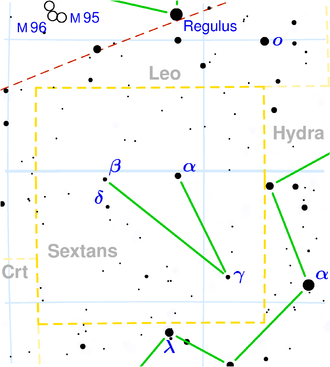NGC 2966
| Galaxie NGC 2966 | |
|---|---|
![NGC 2966 mit LEDA 3355936[1] (l.o.)](http://upload.wikimedia.org/wikipedia/commons/thumb/2/2d/NGC2966_-_SDSS_DR14.jpg/300px-NGC2966_-_SDSS_DR14.jpg) | |
| NGC 2966 mit LEDA 3355936[1] (l.o.) | |
| AladinLite | |
| Sternbild | Sextant |
| Position Äquinoktium: J2000.0, Epoche: J2000.0 | |
| Rektaszension | 09h 42m 11,5s[2] |
| Deklination | +04° 40′ 23″ [2] |
| Erscheinungsbild | |
| Morphologischer Typ | SBc / HII / Sbrst [2] |
| Helligkeit (visuell) | 13,0 mag [3] |
| Helligkeit (B-Band) | 13,8 mag [3] |
| Winkelausdehnung | 2,2' × 0,9' [3] |
| Positionswinkel | 72° [3] |
| Flächenhelligkeit | 13,6 mag/arcmin² [3] |
| Physikalische Daten | |
| Zugehörigkeit | NGC 2962-Gruppe LGG 178 [2][4] |
| Rotverschiebung | 0.006818 ± 0.000023 [2] |
| Radialgeschwindigkeit | 2044 ± 7 km/s [2] |
| Hubbledistanz vrad / H0 | (85 ± 6) · 106 Lj (26,1 ± 1,8) Mpc [2] |
| Geschichte | |
| Entdeckung | Édouard Stephan |
| Entdeckungsdatum | 16. März 1884 |
| Katalogbezeichnungen | |
| NGC 2966 • UGC 5181 • PGC 27734 • CGCG 035-033 • MCG +01-25-013 • IRAS 09395+0454 • 2MASX J09421148+0440233 • Mrk 708 • NVSS J094211+044022 | |
NGC 2966 ist eine aktive Balken-Spiralgalaxie mit hoher Sternentstehungsrate vom Hubble-Typ SBbc[3] im Sternbild Sextant südlich der Ekliptik. Sie ist schätzungsweise 85 Millionen Lichtjahre von der Milchstraße entfernt und hat einen Durchmesser von etwa 55.000 Lj. Gemeinsam mit NGC 2962 und PGC 27248 bildet sie die NGC 2966-Gruppe.
Die Typ-II-Supernova SN 2011in wurde hier beobachtet.[5]
Das Objekt wurde am 16. März 1884 vom französischen Astronomen Édouard Stephan entdeckt.[6]
NGC 2966-Gruppe (LGG 178)
| Galaxie | Alternativname | Entfernung/Mio. Lj |
|---|---|---|
| NGC 2966 | PGC 27734 | 85 |
| NGC 2962 | PGC 27635 | 82 |
| PGC 27248 | UGC 5107 | 83 |
Weblinks
Einzelnachweise
Auf dieser Seite verwendete Medien
Autor/Urheber: Sloan Digital Sky Survey, Lizenz: CC BY 4.0
The sky image is obtained by Sloan Digital Sky Survey, DR14 with SciServer.
Angle of view: 4' × 4' (0.3" per pixel), north is up.
Details on the image processing pipeline: https://www.sdss.org/dr14/imaging/jpg-images-on-skyserver/



